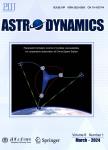Smart dust option for geomagnetic tail exploration
作者机构:Department of Civil and Industrial EngineeringUniversity of PisaPisaI-56122Italy
出 版 物:《Astrodynamics》 (航天动力学(英文))
年 卷 期:2019年第3卷第3期
页 面:217-230页
核心收录:
学科分类:070801[理学-固体地球物理学] 07[理学] 0708[理学-地球物理学]
基 金:This work is supported by the University of Pisa Progetti di Ricerca di Ateneo(Grant No.PRA_2018_44)
主 题:smart dust femto solar sail electrochromic control system geomagnetic tail exploration
摘 要:In-situ measurements are necessary for a long-term analysis of the spatial structure of the geomagnetic *** type of mission requires the use of a propellantless propulsion system,such as a classical solar sail,to continuously rotate the design orbit apse line such that it remains parallel to the Sun-Earth *** reduce the mission costs,this paper suggests the employment of Sun-pointing smart dusts,which are here investigated in terms of propulsive acceleration level necessary to guarantee a mission’s feasibility.A Sun-pointing smart dust can be thought of as a millimeter-scale solar sail,whose geometric configuration allows it to passively maintain an alignment with the Sun-spacecraft *** smart dust external surface is coated with an electrochromic reflective film in such a way that it may change,within some limits,its propulsive acceleration magnitude.A suitable control law is necessary for the smart dust to enable an artificial precession of its Earth-centred orbit,similar to what happens in the GeoSail *** paper analyzes the required control law using an optimal *** particular,the proposed mathematical model provides a set of approximate equations that allow a simple and effective tradeoff analysis between the propulsive requirements,in terms of the smart dust acceleration,and the characteristics of the design orbit.



